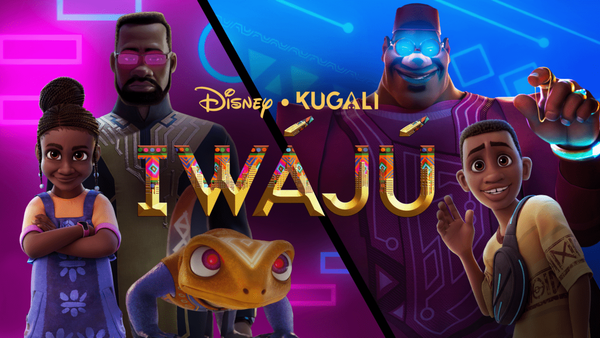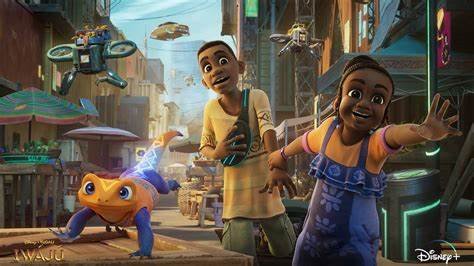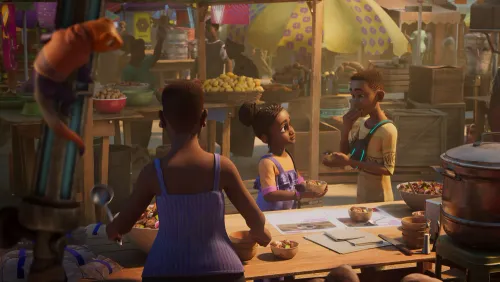

Introduction
What happens when Western money meets African talent? What happens when Disney heads to Nigeria? Will a Nigerian tale translate well to an American audience? Well, stick around, and I’ll share my thoughts.
I enjoy good animation. It can be from Dreamworks, Disney, Studio Ghibli, or a wide variety of other anime or Western animation. From animation masterpieces like Akira to simplistic animation like South Park, and from family-friendly fare like Bambi to less friendly fare like Tripping the Rift.
Breaking the Disney Mold
Of course, as I get older, Disney fare tends to fall into the category of ‘not for me.’ Recently, I watched ‘Iwaju.’ I’m not really its target demographic, as it is aimed at a younger audience. However, since it was produced and set in Nigeria, and I’ve met a lot of people from Nigeria on Hive, I was curious about what it would be like.
On its surface, it’s a tale about a rich kid who wants to explore the world. Being rich and an idealist, she thinks that the poor areas will be fun. However, she finds out otherwise when she is kidnapped, only to be rescued by an AI lizard, friends, and unexpected allies. While it may appear like a typical Disney show where the hero faces a difficult situation and escapes through teamwork, it truly isn’t typical Disney.
First, let me say that it isn’t what I expected. Yes, it had vibrant colors and a telltale Disney feel in terms of animation. However, the storyline was certainly not what I anticipated. “Typical” Disney narratives seem very formulaic to me—good is good, bad is bad. The hero is obvious, and their foe is easily identified. Typically, there’s a heroine who needs saving and a hero who does the job. But “Iwaju” throws all that out.


A City of Contrasts
At first glance, it looks like a straightforward show about the ‘rich family’ from Lagos’s island region who escaped the poverty of the main city. The setting is a futuristic time when technology caters to every desire of the wealthy, while the main city remains impoverished, lacking even the basics. It’s a city of stark contrasts—rich and poor, good and evil.
Shades of Gray
The theme carries over to all of the characters. Without giving too many spoilers, there are several characters: a father (Tunde) and daughter (Tola) from the rich region, a mother (Yemisi) and son (Kole) from the poor region, a gangster (Bode) and henchman (Miss Happy) also from the poor region, a corporate boss (Mrs. Usman), and an AI-powered iguana (Otin). In the city, children are being kidnapped for ransom by the gangster for profit, while the corporation aims to protect the children—for profit. These are flip sides of the same coin.
Over and over I see both good and evil in every character and every situation.


The father provides money but not freedom.
The daughter has a good heart but is very manipulative.
The mother cares deeply for her child but sold his future for medicine.
The son is very bright but lacks a future. He cares for his friend but also betrays her.
The gangster is the greediest person in the show, yet he is also the only source of aid for many.
The gangster’s main henchman exploits children but also cares for them.
Nigeria’s Dilemma
Even the fact that the series was produced in Nigeria but initially couldn’t be viewed there creates a stark contrast.
Viewed in that light, it was actually an engaging show. I was always trying to figure out who was good, who was bad, who played the hero, and who was the antagonist. That’s something I’ve never had to work at with a typical Disney show!
Engaging Uncertinity:
Overall, I’d say that I enjoyed the show more than I would expect from something in a Disney cartoon. However, I’m not sure kids would enjoy it as much. It’s just not black and white enough. As a side distraction, the video was nominally in English, but the actors had thick accents at times, which made it challenging for me on occasion. Additionally, they switched to a native dialect occasionally without subtitles, so there are parts of the show where I’ll never know what they are saying or even which dialect they were using.
Conclusion:
If you’re seeking something that resembles Disney but offers a distinct feel, this might be the show for you. If you’re interested in glimpsing Nigerian life, or at least a Disney portrayal of it, then this show is a good fit. Additionally, if you want a show that sparks discussions about the nature of good and evil, then “Iwaju” is the right choice. However, if you’re expecting a warm and fuzzy Disney picture where good always triumphs over evil, you might be slightly disappointed.


